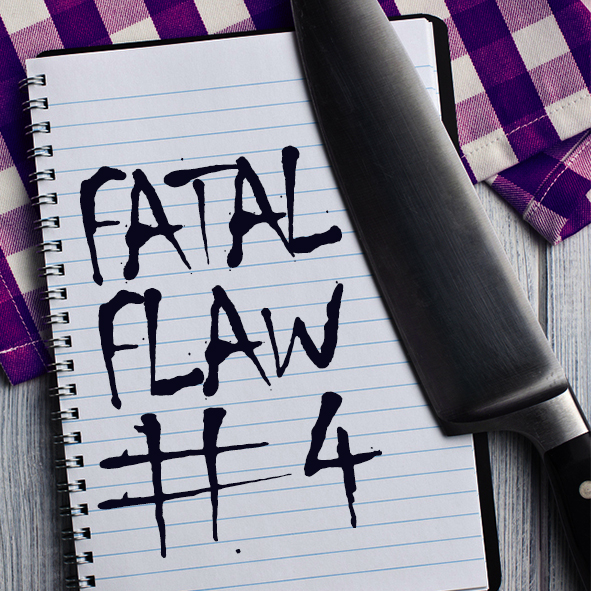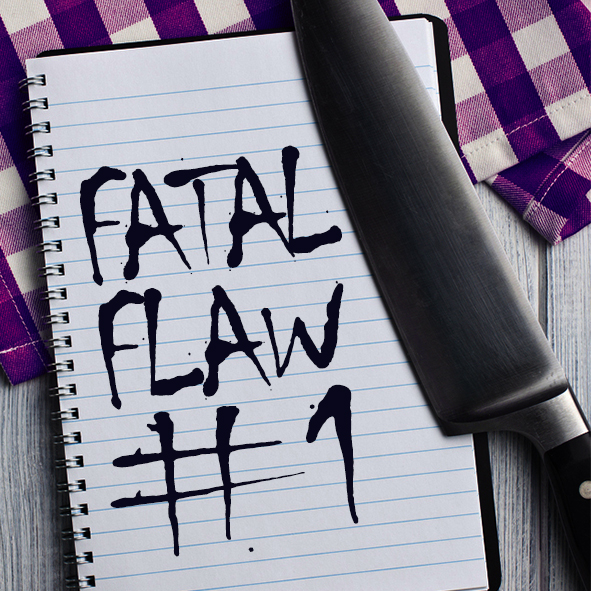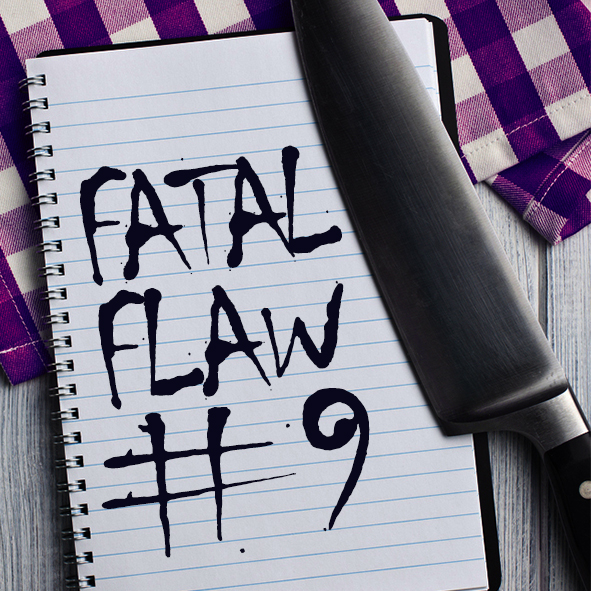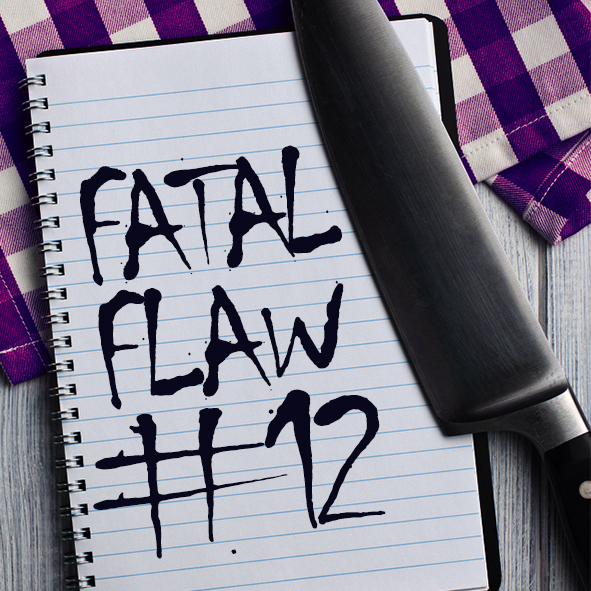How the Rule of Three Can Help Writers Avoid Backstory Slumps
This week editor Linda Clare tackles Fatal Flaw #4—Too Much Backstory. In this month’s posts, we’re looking at the pitfalls of dumping backstory into our scenes and showing ways writers might creatively introduce important information pertaining to a character’s past or necessary to understand the world of the story.
When you use backstory in fiction to deepen characterization or add information about the story, it’s easy for readers to become confused. If readers enter a flashback or backstory and wonder when or where they are supposed to be, confusion often turns to frustration and they stop reading. That’s why it’s so important to craft backstory in an effective way.
Backstory is any narrative passage or scene which occurred in time before the “present-time story.” Your POV character is in a scene when her “mind reels back.” How can readers keep a firm understanding of when and where, in time and space, the story takes them?
Nobody Likes Cold Mashed Potatoes
A simple rule I call the Cold Mashed Potatoes Rule will help ensure that your readers are always oriented to time and place.
The Cold Mashed Potatoes rule goes like this: A character in a scene (maybe the Lady in the White Evening Gown!) sits down at a banquet table and is served a plate of steaming hot, buttery mashed potatoes. Her mouth waters as she digs a forkful and raises it to her lips.
But then something happens. The mashed potatoes remind her of her grandma’s mashed potatoes. Lady remembers that she looked forward to them every year at family dinners. Lady reminisces about how smooth those taters were, how her brothers fought over second helpings, how Grandma always surprised everyone by bringing a second heaping mound out of the kitchen. Grandma’s potatoes had impressed everyone so much that she learned to make a double batch.
While we are learning the reasons for Lady’s love of mashed potatoes, we are transported to Grandma’s kitchen. But what about the banquet table where we started? The forkful of mashed potatoes is still hovering in midair, paused as we travel back in time. And the longer we remain in the backstory, the colder those potatoes get.
I use this illustration to help writers remember that the longer readers are in the backstory, the more the real time scene recedes from their awareness—which is a bad thing.
The Rule of Three
It makes sense, then, to limit the number of backstory sentences you write before at least touching back on the present-time scene. The Cold Mashed Potatoes Rule is easier to work with if you also use the Rule of Three: For every three sentences (or in some cases, paragraphs) of backstory, go back to the present scene at least briefly, to remind readers where the character is actually on stage.
A couple of other considerations will also help you know when and where to insert your backstory. My colleagues all agree that first chapter backstory, if used at all, needs to be short and woven in and around the present action. For every detail but the most crucial, save the backstory for after readers are committed to your character. Use the past perfect (had) only at the beginning and the end of a backstory bit.
And a word about backstory within backstory: don’t do it. Readers are likely to feel hopelessly lost if we begin a flashback about Lady’s grandma and then move into Grandma’s memory of who taught her to make delicious mashed potatoes. If the backstory about Grandma’s youth is more interesting than Lady’s memories, you may want to start the story in a different place.
Let’s look at a before and after example:
Before:
Lady W sat down and smoothed her white silk gown. The butler helped push her chair closer to the table—laden with Sir Lumphrey’s chipped bone china and tarnished silverware. “Evening.” She smiled at her seat mate, Lord Havemuch, and his corpulent wife.
Lorna Havemuch leaned across her husband. “I hear there will be mashed potatoes and roast duck,” she said, licking her lips. “Sir Lumphrey always has the best mashed potatoes.”
Lady W stared at the woman. “That so?”
“Why yes!” Lord Havemuch tied his napkin round his neck. “I can’t wait!”
The servers emerged, bearing steaming tureens of Lord Lumphrey’s famous potatoes, ladling fat globs upon every plate. Lady W picked up her fork, breathing in the delicious buttery smell. As she guided her forkful of potatoes to her mouth, her grandmother’s legendary potatoes came to mind.
When Lady W had been a girl, she looked forward each November to Gran’s luscious mashies. Lady would dream of those delicious potatoes and could scarcely wait until Gran called everyone to the table. Then Gran would present the mashies—so good that Lady’s brothers always fought over who got seconds. Gran refused to tell anyone her secret recipe, although Lady begged her grandma to share it.
When Gran was on her deathbed, she whispered to Lady, “Come closer, dearie. I’ll tell you my secret for those mashies.”
Lady listened closely. Gran had been just a girl herself when her gran had given out the secret recipe. Great-gran took Gran out into the nearby wood, Gran’s worn-out shoes slipping on the loose earth under a tree. She carried a small burlap bag for the secret ingredient, as Great-gran called it.
Suddenly, Great-gran dropped to her knees beneath the oak tree and began scratching at the ground. She bent forward and sniffed loudly. “Hand me the bag,” Great-gran ordered. Gran had obeyed, uncertain how what looked like dirt clods could be the reason the mashed potatoes tasted so heavenly.
Gran heaved a ragged sigh. Lady leaned in closer. “What was it, Gran?”
But Gran’s eyes had closed for the last time, and Lady W had felt tears slide down her cheeks.
“Pass the potatoes, won’t you?” Lord Havemuch’s voice was much too loud and held a vague irritation.
Lady W startled, then stared at her fork, which still hovered in midair. She slid the bite into her mouth, laid down her fork, and passed the tureen. Ugh. The potatoes had not only grown stone cold, they’d never taste like Gran’s. Sir Lumphrey was far too cheap to spring for shaved truffles in a bowl of potatoes. She pushed back from the table.
OK, I admit to having a bit of fun here. The writer probably does need to know how Lady W found out what made Gran’s potatoes so wonderful. But if the backstory is crammed altogether as in the above example, it’s difficult to keep track of when and where readers are supposed to be.
Now let’s see how we can streamline the backstory, using the Cold Mashed Potatoes Rule and the Rule of Three.
After:
Lady W sat down and smoothed her white silk gown. The butler helped push her chair closer to the table—laden with Sir Lumphrey’s chipped bone china and tarnished silverware. “Evening.” She smiled at her seat mates, Lord Havemuch, and his corpulent wife.
Lorna Havemuch leaned across her husband. “I hear there will be mashed potatoes and roast duck,” she said, licking her lips. “Sir Lumphrey always has the best mashed potatoes.”
Lady W stared at the woman. “That so?”
“Why yes!” Lord Havemuch tied his napkin round his neck. “I can’t wait!”
The servers emerged, bearing steaming tureens of Lord Lumphrey’s famous potatoes, ladling fat globs upon every plate. Lady W picked up her fork, breathing in the delicious buttery smell. As she guided her forkful of potatoes to her mouth, her grandmother’s legendary potatoes came to mind.
When Lady W had been a girl, she’d looked forward each November to Gran’s luscious mashies. Lady would dream of those delicious potatoes and could scarcely wait until Gran called everyone to the table. Then Gran would present the mashies—so good that Lady’s brothers had always fought over who got seconds.
Lord Havemuch elbowed Lady W. “Pass the butter please.”
Lady W set down her fork and obliged. Lord Havemuch piled at least five butter pats upon his potatoes. Gran’s potatoes had never needed that much butter—they were scrumptious all by themselves.
Gran had refused to tell anyone her secret recipe, although Lady had begged her grandma to share it. Then, when Gran was on her deathbed, she’d whispered to Lady. “Come closer, dearie. I’ll tell you my secret for those mashies.”
Now Lady tasted the potatoes in front of her. No, these were definitely not as good as Gran’s.
Lady remembered that Gran had heaved a ragged sigh and leaned in closer. “What is it, Gran? What’s the secret?”
But Gran’s eyes had closed for the last time, and Lady W’s tears had slipped down her cheeks.
“I said, pass the potatoes, won’t you?” Lord Havemuch’s voice was much too loud and held a vague irritation.
Lady W startled. She slid the next bite into her mouth, laid down her fork and passed the tureen. Ugh. Sir Lumphrey’s potatoes had not only grown stone cold—they’d never taste like Gran’s. Sir Lumphrey was far too cheap to spring for shaved truffles in a bowl of potatoes. She pushed back from the table.
In the second example, we only go into one flashback. I used the Rule of Three in each bit of backstory, careful to insert the past perfect “had” at the beginning and ending of that bit. By bouncing back into the real time scene, readers are reminded of where Lady really is, and confusion is lessened.
So, yes, you do need bits of backstory. But if you abide by the Rule of Three, keeping those cold potatoes in mind, you won’t lose your readers.
Your turn:
Have you ever read backstory that was a story within a story and became confused or read it twice? What’s the most difficult aspect of writing flashback or backstory for you? Do you have other methods of inserting backstory into a scene?











This is great advice. I may have erred more than once in creating character, providing a whole chapter to reveal elements of another character’s personality and ability, but to use the rule of three seems possibly to cut up the information and in itself be confusing. I’ll be grateful if you would read a bit in one book I have in mind and comment on it. I’ll gladly provide PDF copy of the book. If ever you requested my presence or writing on a topic that would be of use, I’d gladly comply.
Larry,
Thanks so much for your offer. Unfortunately, my plate is pretty full these days. As to your comment that, “to use the rule of three seems possibly to cut up the information and in itself be confusing,” the language gives us tools to keep confusion at bay. The past perfect “had” and the use of simple transitions (then, now) are usually enough to keep readers straight about the time factor. It’s also helpful to enter and leave back story with a “touchstone.” Often in life we are transported to an earlier time by a sensory clue: we see, hear or smell something in the NOW that reminds us. Using this trick might help keep your back story from seeming “cut up.”
Keep Writing,
Linda
Linda, “Nobody Likes Mashed Potatoes” and “The Rule Of Three” are terrific. I do have this problem from time to time in the middle of a real time scene. Your handy monikers for remembering to avoid going on and on when I do this are most helpful.
There are times when I deliberately violate this excellent rule. I wonder what you would think. It happens in three situations. First, in the middle of a narrative passage I will permit a character to go on for more than three lines if his internal reflections take him away from real time. I try to solve the problem of confusion of time and place by using setting clues to let the reader know that real time has been left and then returned to. Of course, letting it go on too long takes the reader from whatever tension I am trying to build into real time.
Second, I will begin or end a chapter with a paragraph or two of backstory but always when it is clear to the reader where the character is planted in a real time setting, that is, where he is when his mind is drifting back in time. I try not to do this too often but find that this way is less interruptive of the flow of real time.
Third, I may have a whole chapter of backstory, but only rarely. It is like transporting the reader out of real time for a closer look at a character’s past. This makes it easier to have a real scene in the past rather than slipping into the mistake of telling too much rather than showing.
If you have the time, I’d love to hear your comments on this.
Thanks so much for the helpful column.
Jim Steinberg
Jim,
Thanks for your comments. I think you leave clues in your answer– “letting it go on too long takes the reader from whatever tension I am trying to build into real time.” To me, that’s a key factor in deciding how much back story the story can tolerate in any one place. The Rule of Three is always subjective–no doubt there are many exceptions written by famous and not-so-famous writers. The “rule” is meant as a guideline–not to be strictly enforced but rather to remind writers not to get carried off in the back story so the reader loses the real time scene. Hope this helps! Keep Writing!
Linda
Linda, t
Thank you for your quick response. Thinking of it as a guideline rather than a rule…that’s a great way to regard it. I tend to get carried off into backstory. There are other ways to allow characters to be reflective. This will help me keep being careful in mind, and it will help lots of writers, especially newer ones.
I really enjoyed your post.
Jim
What a great tip!
And so simple – reminiscent of Blake Snyder’s easy directions in Save the Cat.
Thank you!
Thanks so much for sharing, Linda.
I like your take on doling out snippets of backstory.
Best wishes,
Dirk
Dirk,
I’m glad to help. The main thing is not to have the main story forgotten by readers!
Keep Writing,
Linda
My writing teacher in college used to say that flashback was the flea and the story was the dog. The flashback gets to big or too many and it eats the dog!
Of course it’s not a perfect analogy: I prefer my dogs flealess, but backstory in a novel is certainly necessary.
Thanks for your examples. I’m editing my first chapter of my WIP and I found places to add sensory details of the present to anchor the on-going action and break up my bits of backstory.
Sara
Sara,
Love the flea and dog example! My cats have a few fleas but not nearly as many as you’d expect given they have nine lives.
Keep Writing!
Linda
I like it! As ever, one of your articles being pertinent to where I’m up to in yet another editing session! I love the spuds!
Susannah,
I had fun writing about them spuds too! Lord Havemuch and Sir Lumphrey may make another appearance in these posts. Glad you found the info helpful.
Keep Writing,
Linda
I’ve actually seen the “cold mashed potatoes” thing in action with some of the books I’ve read. Most of the time, it happens during interaction between the characters. A question is asked by the hero and the heroine goes off into her own thoughts, and then we’re brought back. But by that time, I’d forgotten what the hero had asked her! Thank you for this post and I will definitely be more aware now of how I weave in backstory.
Evolet,
How disconcerting to know there are published novels with cold mashed potatoes! Ah well, one thing is for sure–the editing rules are not always consistent (or followed) by editors. But I believe in high standards.
Keep Writing,
Linda
Linda, I’ll pass along the idea of cold potato pancakes to you and pass along the link for your article to readers of the Christian Poets & Writers blog 🙂 Blessings.
Great advice! I read a book a few years ago, in which the heroine sat down at a ball game with her drink and hot dog, and proceeded to reminisce about an event for about twenty five pages! I remember being confused at the time (I didn’t know then about story structure and back story). Eventually the story returned to the scene at the ball game. Her coke must have gone flat and her hot dog must have gone very cold in the meantime!!
Linda, thanks so much for writing this! I write for academics in my day job, and the only English class I took in college was required, so I’m glad to read cogent advice like this.
Cheers,
Nathan
Great advice, definitely! I may use it someday. I’m still finding my voice. Currently whenever I reveal backstory it’s through the characters mentioning it to each other. Or it’s revealed some other way, by how they speak, dress… how they decorate their house; what’s in their bookcase. Kind of like a movie.